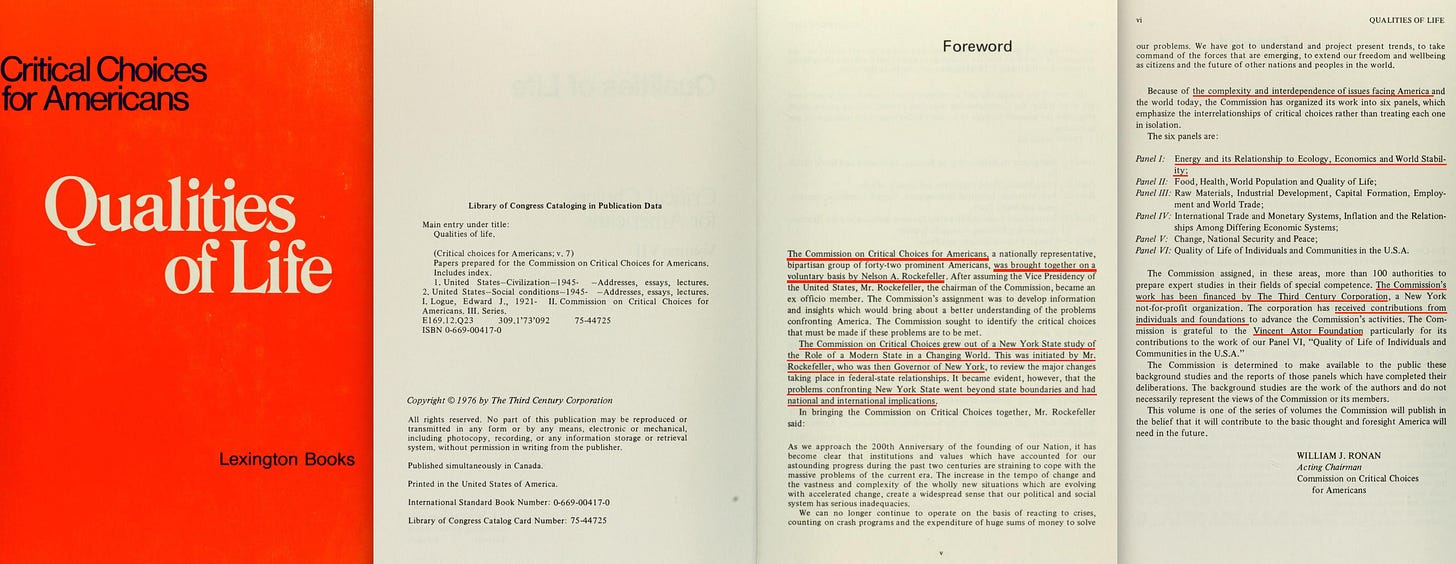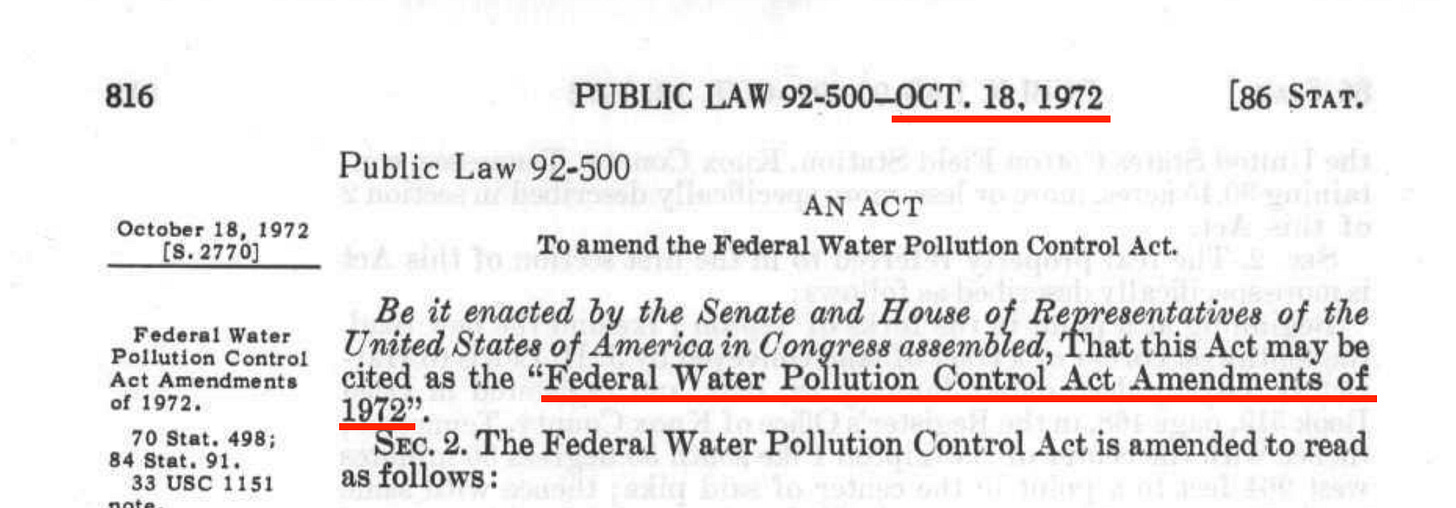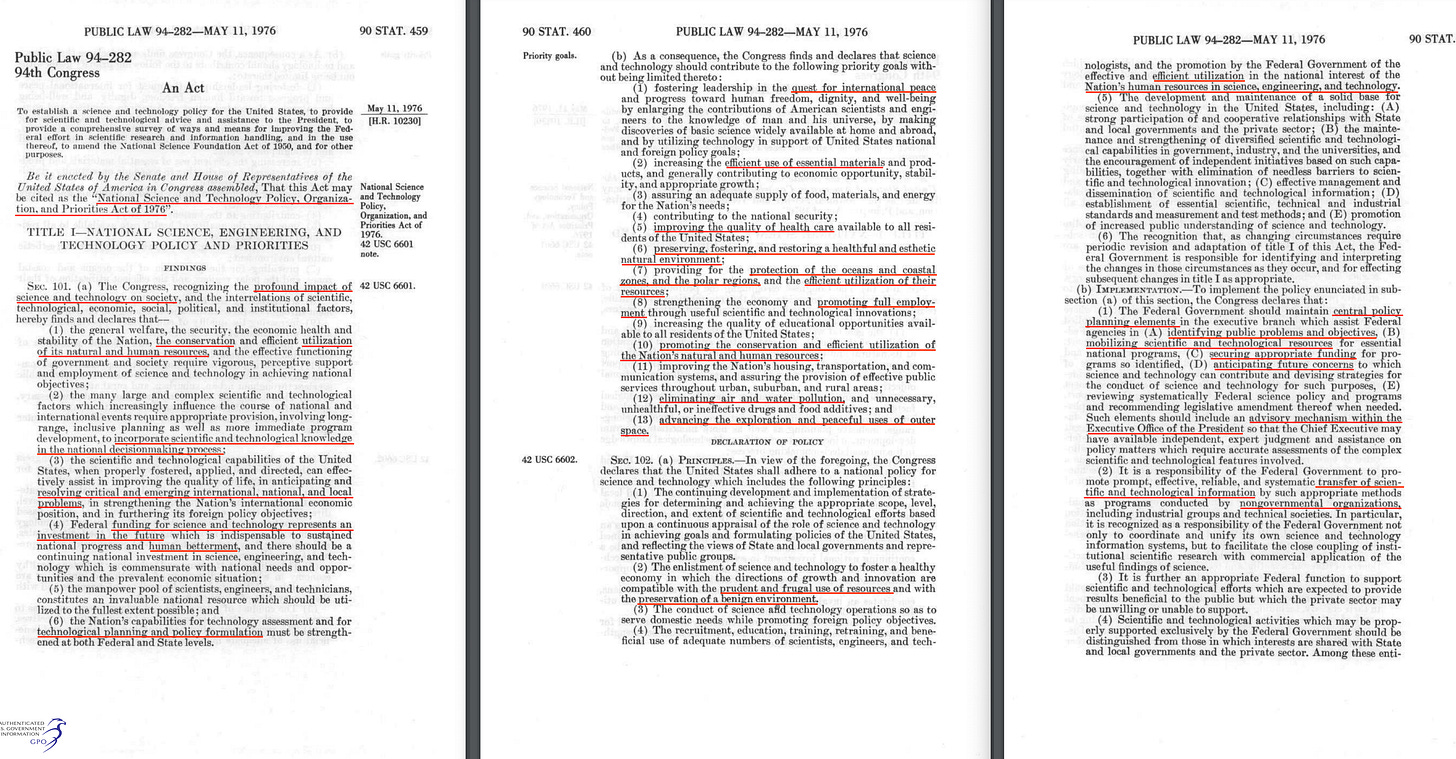I never had much interest in 1970s politics. Never found it particularly exciting.
How wrong I was.
In 1973, Tricky Dick put together a working group titled the 'Commission on Critical Choices for Americans', tasked with establishing what would happen in the event of a rapid change brought upon the US, and what would be the outcome in terms of their global hegemony.
The committee was chock full of VIPs, including Nixon's VP, Gerald Ford, his Secretary of State, Henry Kissinger, Secretary of Treasury, George Schultz. And in charge of this committee, he put Nelson Rockefeller, grandson of John D himself.
The study was funded through a special vehicle created for the purpose - the Third Century Corporation - and when half of its funding need was met, it transpired that almost two thirds was donated by Rockefeller and his brother.
A total of 42 members partook - including Nelson Rockefeller himself - yet in spite of claims of impartiality, no less than 22 either currently worked in a government position, or did previously. And George Woods, the former World Bank president, also contributed.
At the time, Rockefeller was the acting Governor of the state of New York, a job from which he resigned, to dedicate himself to this study. And there is one panel in particular which is of interest in more contemporary settings. Panel 1, to be specific.
Because it touched upon two particular topics - natural resources, and energy policy. Topics which still are, to this day, hotly debated if not through resource depletion, then through claims of climate change.
Though these documents are neigh-on impossible to track down on the web, archive has preview versions. And panel 6 - Qualities of Life - outline a bit of extra detail, like the study being the result of a similar commissioned in New York, titled ‘Role of a Modern State in a Changing World‘. Trouble was it didn’t really apply, as the state itself was too narrow a scope.
And what happened next?
In August, 1974, Richard Nixon fell from grace, as an outcome of the Watergate scandal. His VP, Gerald Ford, received a promotion, and eventually appointed Nelson Rockefeller the new Vice President.
This chain of events does pose questions in my inquisitive mind, but that’s a rabbit hole of which I will steer clear.
Regardless, it's on this background that an act was passed in May, 1976, which is of remarkable importance in more contemporary settings. Specifically, Public Law 94-282—May 11, 1976. to which we will return in a minute.
Because let’s just establish what the at-the-time common phrase ‘Rockefeller Republican’ means. Because this was no ordinary Republican.
Yes, this ‘republican’ was pro-Universal Healthcare, pro-environmentalism, pro-water regulation, and pro-taxation. And to clarify - the point here isn’t whether you agree with any of those - the point is that his political views appear far closer to that of a 70’s Democrat. Almost Carter’esque.
Nixon furthermore also appointed him chairman of the National Commission on Water Quality in 1973, following the ‘Federal Water Pollution Control Act Amendments of 1972‘.
-
But back to the act in question, which opened the floodgates of contemporary hell. It’s the ‘National Science and Technology Policy, Organization, and Priorities Act of 1976‘
But why?
No, it’s not the environmentalism, or the principles of conservation, which are progressively merged into the National Science Foundation Act of 1950. It’s not the decision to ‘incorporate scientific and technological knowledge in the national decisionmaking process’, though we’ve certainly seen plenty of abuse in that regard.
It’s not the ‘quest for international peace’, which frankly sounds a bit commie if you ask me. It’s not the promise to ‘improve the quality of health care’, which - as far as I’m concerned, shouldn’t even be in that document, full stop.
It’s not the ‘protection of the oceans and coastal zones, and the polar regions‘, or the false promise to ‘promote full employment through useful scientific and technological innovations‘, and nor is it ‘prudent and frugal use of resources and with the preservation of a benign environment‘ we see in sec 102.a.2.
And no, it’s not a trick question - it’s not ‘all of those’ either. It could be, perhaps even should be - but it isn’t.
Nor is it ‘systematic transfer of scientific and technological information by such appropriate methods as programs conducted by nongovernmental organizations‘, which will obviously will primarily serve to line the pockets of those NGOs.
Some things truly never change.
Nor is it ridiculous claims of ‘add to the cultural heritage of the Nation‘, or ‘Closer relationships should be encouraged among practitioners of different scientific and technological disciplines, including the physical, social, and biomedical fields‘, which in more contemporary times has been used to conflate different - and fundamentally incompatible - fields of science, to introduce judgment calls, and thus allow for a corruption of the scientific process. No, not that either, though that in itself is bad. Very bad.
And it’s not the creation of the ‘Intergovernmental Science, Engineering, and Technology Advisory Panel‘, either, though we’re getting closer.
Oh wait, these are the final pages. Where is it?
We actually already scrolled past. It’s title II, the ‘Office of Science and Technology Policy‘. Innocuous, no?
And the reason why, is because of what took place on Wednesday, June 12,1996.
It’s the day the plan came alive.
It’s the day President Clinton ‘established a national policy to address the threat of emerging infectious diseases through improved domestic and international surveillance, prevention, and response measures‘.
See if you recognize any of these policy goals, with a particularly keen eye on goal 5 -
‘… establish the authority of relevant United States Government agencies to contribute to a worldwide infectious disease surveillance, prevention, and response network…‘
Yeah, that’s the global surveillance initiative.
5 years before 9/11 was even a thing.
The next section, ‘US Government Roles and Responsibilities‘ is even worse -
Goal 2 alone manages to drag in behavioural science, antimicrobial resistance, zoonotic disease events, and climate change!
Goal 4 casually adds quarantines at ports, increased surveillance after entry, and just casually broadens the scope to animals and materials as well. And that, actually, is a major deal, especially in the context of European legislation speaking of similar already in 1992. All of this was coordinated. All of it.
Goal 7 outlines the role of the WHO in great detail, suggests revisioning the International Health Regulations, and refers to regional inventories of resources - ie, stockpiling.
And Goal 8 pushes it even further by demanding vastly increased powers, loops in the Department of Defense on the surveillance action, and casually speaks of the existing DoD overseas laboratories. Wait, what now, in a document from 1996?
The document completes by establishing a ‘Task Force of the National Science and Technology Council’, referring to the 1993 NSTC which had only recently come into existence. And controversially so.
And - for the record - I’m not going to blame either Team Blue (aka Clinton), or Team Red (aka Bush) here, because the truth is that there’s no bloody differences between the two. The only difference is order of implementation of policies, and the noise created by a complicit mainstream media.
And yes, that goes for Fox just as well as CNN.
Earlier in the document we saw a few references. I won’t make a meal out of it, because if you’ve follow contemporary pandemic planning, you know exactly where this is heading.
Surveillance, vaccines, zoonotic events, big pharma liability waivers, laboratories, centralised database, cash for research, the WHO, ‘timely sharing of infotmation’, stockpiles, and on and on and on it goes.
-
The most interesting of the three documents can be found here. Global Microbial Threats in the 90s.
As said, there’s nothing terribly surprising here, but this I did find of interest.
I took the liberty of colour coding the various departments, and only included ‘leaf’ nodes in the hierarchy. Blue is health. Orange is military. Green is environmentalism. Yellow is everything else.
Given that this is supposed to be about health, this appears somewhat underrepresented… in fairness, it doesn’t say anything about participation level per department, but trawling plenty of other, similar documents, representation tends to be one, max two, per department. But that’s rare.
Health appears a tad… short.
The executive summary bangs the vaccine narrative, and carries on, conflating health with climate, ecology, and deforestation. Almost as though this isn’t really about health.
The recommendations of the CSET working group include surveillance of antibiotic resistance - and zoonoses.
In 1996.
The fake H5N1 episode in Hong Kong hadn’t even yet taken place.
We also see the likes of the CDC, DoD, and USAID offering to ‘help out partner nations’, implementing global surveillance.
Another minor point here is the sheer level of attention to detail. Here’s an example thereof, ‘Building Surveillance Capacity in Sub-Saharan Africa‘. They really have spent a fair bit of time thinking this through, no?
And the final part I wish to draw attention to is here, a reference to the ‘draft Pandemic Influenza Plan’. Yeah, of course that was coordinated just as well.
As is it no surprise either that European initiatives kick in around the same time - not just in terms of pandemic planning, but also what took place in the 70s. More on that later.
And if you now sit with the feeling that all of this is building up to something bigger, then I can categotically state that you are absolutely right.
And it’s not the pandemic treaty.
It’s something far worse.
…
And it relates to Goal 8.




























Incredible research. Thank you!
Great research, very much appreciated. I'm sure you're aware of this gentleman's work
https://drjacobnordangard.substack.com/p/2228-2